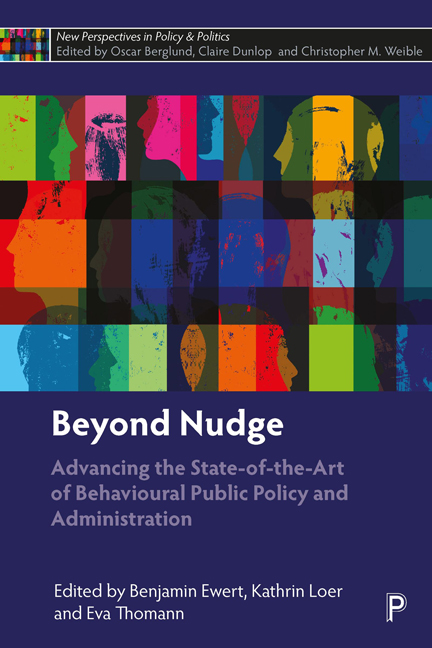Book contents
- Frontmatter
- Contents
- List of figures and tables
- Notes on contributors
- Acknowledgements
- 1 Beyond nudge: advancing the state-of-the-art of Behavioural Public Policy and Administration
- 2 Advancing behavioural public policies: in pursuit of a more comprehensive concept
- 3 A behavioural model of heuristics and biases in frontline policy implementation
- 4 Who are behavioural public policy experts and how are they organised globally?
- 5 Why nudge sometimes fails: fatalism and the problem of behaviour change
- 6 Behavioural insights teams in practice: nudge missions and methods on trial
- 7 Can street-level bureaucrats be nudged to increase effectiveness in welfare policy?
- 8 What motivates street-level bureaucrats to implement the reforms of elected politicians?
- 9 How can better monitoring, reporting and evaluation standards advance behavioural public policy?
- 10 Conclusion
- Index
4 - Who are behavioural public policy experts and how are they organised globally?
Published online by Cambridge University Press: 28 March 2024
- Frontmatter
- Contents
- List of figures and tables
- Notes on contributors
- Acknowledgements
- 1 Beyond nudge: advancing the state-of-the-art of Behavioural Public Policy and Administration
- 2 Advancing behavioural public policies: in pursuit of a more comprehensive concept
- 3 A behavioural model of heuristics and biases in frontline policy implementation
- 4 Who are behavioural public policy experts and how are they organised globally?
- 5 Why nudge sometimes fails: fatalism and the problem of behaviour change
- 6 Behavioural insights teams in practice: nudge missions and methods on trial
- 7 Can street-level bureaucrats be nudged to increase effectiveness in welfare policy?
- 8 What motivates street-level bureaucrats to implement the reforms of elected politicians?
- 9 How can better monitoring, reporting and evaluation standards advance behavioural public policy?
- 10 Conclusion
- Index
Summary
Introduction
Since 2010, behavioural public policy has spread inter-and transnationally. In more than 100 countries, expert units focusing on nudging and other behaviourally informed tools are translating insights from behavioural sciences into policy interventions. Existing interpretations of the behavioural movement and its impact on public policy vary considerably (John, 2013; Whitehead et al, 2014; John and Stoker, 2019; Strasheim and Beck, 2019).
To move beyond very general explanations, this chapter focuses on two specific approaches to expertise and public policy. Since the mid-1990s, research on ‘epistemic communities’ has provided a deeper understanding of actor collectives and the influence of knowledge, beliefs and learning in the policy process. More recently, the concept of ‘instrument constituencies’ (Voss and Simons, 2014; Howlett and Mukherjee, 2015; Beland et al, 2018; Simons and Voss, 2018) has stirred a fruitful debate on the different ways collective agency at the science– policy nexus can be conceptualised. After developing typologies and criteria that help to sharpen the distinction between both concepts, recent studies have started to explore the overlaps between both (Howlett and Mukherjee, 2015; Sturdy, 2018; Zito, 2018). Wondering how ‘clean the conceptual break is’ (Zito, 2018: 52), some scholars are highlighting puzzling cases in which instrument constituencies cannot be clearly distinguished from other types of collective entities.
Behavioural expertise and public policy is one of these puzzling cases at the margin between both concepts (John, 2018; Mukherjee and Giest, 2020). ‘This community’, as Zito (2018: 51) has recently observed, ‘is particularly interesting as it is at the border between EC and IC approaches’. Behavioural expert networks seem to be oscillating between two opposed modes of collective action: as epistemic community, they generate and distribute validated knowledge about the cognitive systems of citizens, based on the consensual belief that the heuristics and biases in individual behaviour pose a core challenge for policy making. As instrument constituency, they bring together a great diversity of different actors and worldviews, unified only in practices of using this knowledge for developing nudges and other behaviourally informed tools and translating these designs into varied areas of policy making. By focusing on a case that seems to be shifting between epistemic communities and instrument constituencies this chapter aims at highlighting the analytical potentials and limits of each concept.
- Type
- Chapter
- Information
- Beyond NudgeAdvancing the State-of-the-Art of Behavioural Public Policy and Administration, pp. 67 - 87Publisher: Bristol University PressPrint publication year: 2023

